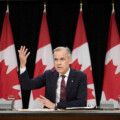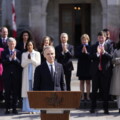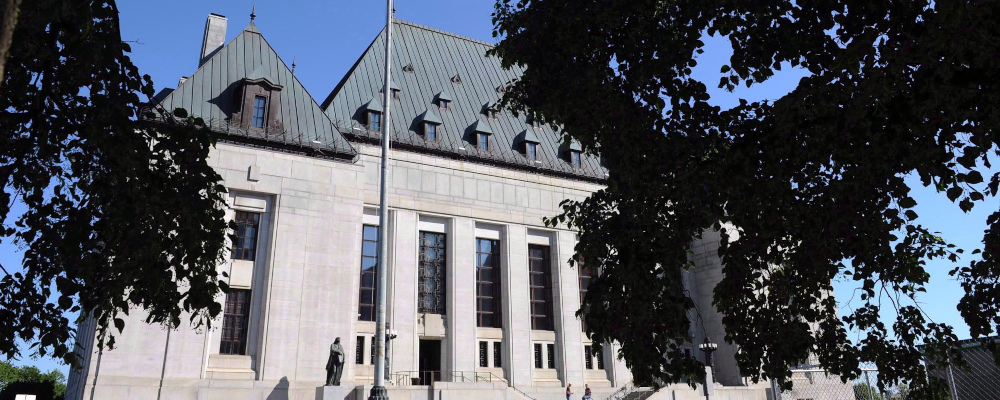2022 marks a major milestone for Canada: the 40th anniversary of the Constitution Act, 1982. This statute, which took effect on April 17, 1982, secured three major milestones for Canada.
First, it transferred full care and control over the Canadian Constitution from the United Kingdom to Canada. Second, it adopted a set of rules by which Canada could amend its Constitution. Third, it embedded a bill of rights, the Canadian Charter of Rights and Freedoms, into the Constitution. Barry Strayer, an esteemed Canadian jurist and one of the architects of the changes to our Constitution in 1982, aptly called this moment a constitutional revolution.
To mark this anniversary, I propose to make a whistle-stop journey through Canada’s constitutional history. This journey, which will finish in April to coincide with the anniversary of the Constitution Act, 1982, will have four stops: our constitutional landscape before 1982, how 1982 came about, the story after 1982, and the future of the Canadian Constitution.
The 40th anniversary of Canada’s constitutional revolution is an ideal moment to undertake what is a worthy endeavour at any time. In a society ruled by law, the portion of our law that governs all state action is of fundamental significance. The Constitution creates and sustains the basic features of Canadian society. It shapes our daily lives far more than we appreciate.
We only stand to benefit by deepening our knowledge of our Constitution. In doing so we will surely deepen our knowledge of Canada—a country that, though imperfect, merits affection and admiration. One might even say that, by learning about the law that constitutes Canada, we will grow in “true patriot love” for this remarkable country.
Part IV: The Charter’s Future
Part III of this series offered a snapshot of how the Charter has profoundly shaped Canadian society over four decades.The Charter at Forty: How the Charter has shaped society since 1982 https://thehub.ca/2022-04-18/charter-at-forty-how-canadas-charter-has-shaped-society-since-1982/ There is no reason to think that the next four decades will be any different. In the final part of this series, I share a few thoughts on the uncharted waters to which the Charter may lead us.
Even after 40 years, several provisions of the Charter have been either partially or entirely forgotten. Among the “fundamental freedoms” in section 2 of the Charter, several await meaningful judicial consideration.The Charter’s forgotten fundamental freedoms https://policyoptions.irpp.org/magazines/june-2020/the-charters-forgotten-fundamental-freedoms/ Freedom of conscience, freedom of thought, and freedom of peaceful assembly have largely gathered dust since 1982. Other provisions of the Charter have arguably been under-interpreted. Freedom of association, for example, has been confined to the collective bargaining context. In the years to come, new ground may be broken on these and other Charter guarantees that have been neglected or underdeveloped.
In addition to forgotten rights and freedoms, there are also many forgotten foundations of the Canadian Constitution—bedrock principles and ideals that sustain and animate the Constitution—that call for excavation. One example is the concept of a “free and democratic society,” a phrase that appears in the first section of the Charter. Section 1 “guarantees” the rights and freedoms found in the Charter and says that they are “subject only to such reasonable limits prescribed by law as can be demonstrably justified in a free and democratic society.” Section 1, in other words, both activates the rights and freedoms in the Charter and articulates the standard by which they can be curtailed by state actors.
Section 1 may be the most consequential provision of the Charter. Many landmark Charter cases turn not on whether the right or freedom at stake has been limited by governments, but on whether the limit is justifiable. Even so, certain aspects of the text of section 1 have been insufficiently treated by courts and scholars—and the “free and democratic society” phrase may take top prize in that regard.
The most extensive judicial treatment of this phrase occurred in R. v. Oakes (1986), the leading Supreme Court ruling on section 1. The reflections of Chief Justice Brian Dickson in Oakes on the basic ingredients of a “free and democratic society” are worth quoting in their entirety:
Inclusion of these words as the final standard of justification for limits on rights and freedoms refers the Court to the very purpose for which the Charter was originally entrenched in the Constitution: Canadian society is to be free and democratic. The Court must be guided by the values and principles essential to a free and democratic society which I believe embody, to name but a few, respect for the inherent dignity of the human person, commitment to social justice and equality, accommodation of a wide variety of beliefs, respect for cultural and group identity, and faith in social and political institutions which enhance the participation of individuals and groups in society. The underlying values and principles of a free and democratic society are the genesis of the rights and freedoms guaranteed by the Charter and the ultimate standard against which a limit on a right or freedom must be shown, despite its effect, to be reasonable and demonstrably justified.
Limits on Charter rights and freedoms must be compatible with the nature and demands of a free and democratic society. Cultivating and then applying a nuanced understanding of this concept is especially important when courts are called upon to adjudicate cases that feature a collision of rights. In Oakes, Chief Justice Dickson identifies what might be termed “robust pluralism” as a cornerstone of a free and democratic society. It is arguable that this vision of pluralism, one which makes ample space for diversity and difference, has been unevenly affirmed in Charter jurisprudence. Our understanding of a “free and democratic society” in the context of evaluating limits on Charter rights and freedoms remains under construction.
Another construction zone for the Charter is the so-called “notwithstanding clause” in section 33. This clause permits legislatures to enact laws that effectively bypass certain rights and freedoms guaranteed by the Charter. The notwithstanding clause has been a political lightning rod from even before the ink dried. An unabashed political compromise to pacify certain provincial governments of the day, Pierre Trudeau opposed the clause because of the threat he perceived it posed to the project of entrenching rights and freedoms within the supreme law of Canada. The silver lining, however, has been the deep reluctance of governments to use the clause due to the political costs of muting Charter rights and freedoms.
But this silver lining has faded in recent years, as the notwithstanding clause has come to be used more often by provincial governments. The current litigation over Quebec’s Bill 21, a law that forbids certain public servants from wearing religious symbols at work, may require the Supreme Court to determine how ironclad the notwithstanding clause truly is. At a first glance, Quebec should prevail on account of having invoked section 33 when it enacted Bill 21. Owing to the use of section 33, Quebec has argued that any Charter claims of religious freedom, freedom of expression, equality, or other guarantees captured by section 33 should fail.
But what if the Constitution guarantees civil liberties like freedom of religion and freedom of expression in constitutional spaces apart from the Charter? In opposition to Bill 21, some have argued—by pointing to Supreme Court rulings and our constitutional inheritance from the United Kingdom—that these and other basic protections found expression in the Constitution prior to the Charter, and that the notwithstanding clause (which only operates on certain Charter rights and freedoms) does not necessarily affect these guarantees. The intriguing question of whether the Charter covers the field of rights protection in the constitutional sphere merits consideration by the Supreme Court. The robustness of the notwithstanding clause, the most controversial aspect of the Charter, is poised to be determined in the years to come.
Finally, there is the matter of which social and policy issues will take centre stage in Charter litigation in the years and decades to come. Making predictions of this sort might seem futile given that many of the issues that have featured in Charter litigation of the past 40 years were unfathomable as of 1982. I find it hard to imagine that many Canadians foresaw the Charter being argued in cases about euthanasia, prohibitions on private health care, and same-sex marriage—to name only a few issues.
Even so, it seems plausible to predict that issues like digital privacy and other matters related to technological advances will loom large in Charter litigation of the not-so-distant future. The same can be said of the major challenges we face as a society and as a planet, such as reconciliation and climate change. The question of how we ought to manage the inevitable tensions and disagreements that occur within a plural society will continue to knock on courtroom doors. The litigation over Quebec’s Bill 21 is a prime example.
And certain issues that have already generated landmark rulings will likely return to the Supreme Court again. In 2007, the Court considered a ban on private health care in Quebec; the Court may have the opportunity to consider the issue again in a case emanating from British Columbia.B.C. Supreme Court rules against legalizing private health care following decade-long battle https://bc.ctvnews.ca/b-c-supreme-court-rules-against-legalizing-private-health-care-following-decade-long-battle-1.5099737 The rapid expansion of euthanasia—in the wake of the Court’s ruling in 2015 that opened the door to the legalization of this practice—could spark claims by vulnerable Canadians that this approach jeopardizes their right to life and the security of the person. Abortion, owing to the constitutional winds that are gusting from the United States, could also return to the Court down the road for a determination as to whether the Charter guarantees a right to abortion.Why Canada’s Roe v. Wade didn’t enshrine abortion as a right https://www.cbc.ca/news/canada/abortion-rights-canada-morgentaler-court-1.6439612
The Charter did not come with a crystal ball when it arrived in 1982. The truth is that, in the decades to come, many issues that none of us can currently imagine will reach the Supreme Court through the vehicle of Charter litigation. One thing I am sure of is that it will be fascinating—and astonishing from the perspective of 2022—to survey our constitutional landscape on the 80th anniversary of the Charter. If the first four decades are any indication, the next four also promise to be transformative for Canada and Canadians alike.
Recommended for You

‘He’s going to be a radical prime minister’: Scott Reid on what to expect with Carney’s cabinet picks and how the new PM will govern

Scott Reid: Three key things for Carney to consider as he builds his government

The Weekly Wrap: A potential star for Carney’s cabinet

The Notebook by Theo Argitis: Reading the signals in Carney’s cabinet picks




